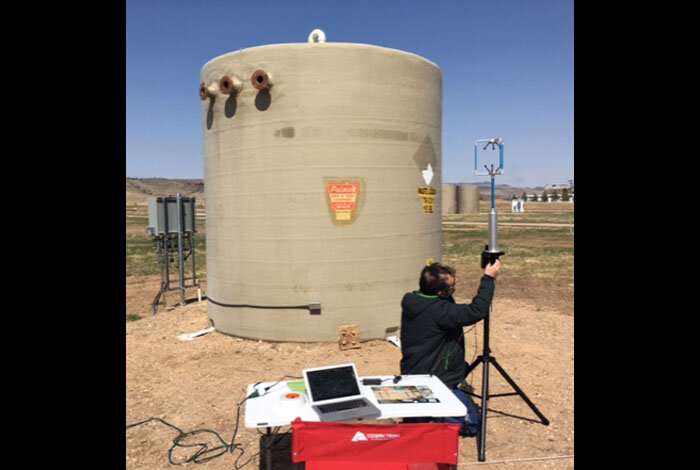Sensors driven by machine learning sniff-out gas leaks fast

A new study confirms the success of a natural-gas leak-detection tool pioneered by Los Alamos National Laboratory scientists that uses sensors and machine learning to locate leak points at oil and gas fields, promising new automatic, affordable sampling across vast natural gas infrastructure.
"Our automated leak location system finds gas leaks fast, including small ones from failing infrastructure, and lowers costs as current methods to fix gas leaks are labor intensive, expensive and slow," said Manvendra Dubey, the lead Los Alamos National Laboratory scientist and coauthor of the new study. "Our sensors outperformed competing techniques in sensitivity to detecting methane and ethane. In addition, our neural network can be coupled to any sensor, which makes our tool very powerful and will enable market penetration."
The Autonomous, Low-cost, Fast Leak Detection System (ALFaLDS) was developed to discover accidental releases of methane, a potent greenhouse gas, and won a 2019 R&D 100 award. ALFaLDS detects, locates and quantifies a natural gas leak based on real-time methane and ethane (in natural gas) and atmospheric wind measurements that are analyzed by a machine-learning code trained to locate leaks. The code is trained using Los Alamos National Laboratory's high resolution plume dispersion models and the training is finessed on-site by controlled releases.
Test results using blind releases at an oil and gas well-pad facility at Colorado State University in Fort Collins, Colorado, demonstrated that the ALFaLDS locates the engineered methane leaks precisely and quantifies their size. This novel capability for locating leaks with high skill, speed and accuracy at lower cost promises new automatic, affordable sampling of fugitive gas leaks at well pads and oil and gas fields, the paper in the journal Atmospheric Environment: X concludes.
ALFaLDS's success in locating and quantifying fugitive methane leaks at natural gas facilities could lead to a 90 percent reduction in methane emissions if implemented by the industry.
ALFaLDS used a small sensor, which makes it ideal for deployment on cars and drones. The Los Alamos team is developing the sensors that were integrated with a mini 3-D sonic anemometer and the powerful machine-learning code in these studies.
However, the code is autonomous and can read data from any gas and wind sensors to help find leaks fast and minimize fugitive emissions from the vast network of natural gas extraction, production and consumption.
With this integration, ALFaLDS offers a revolutionary approach for oil and gas service providers in leak detection, to non-profit organizations surveying the issue, and to national laboratories and academia researching natural gas production.
More information: Bryan Travis et al, Neural networks to locate and quantify fugitive natural gas leaks for a MIR detection system, Atmospheric Environment: X (2020). DOI: 10.1016/j.aeaoa.2020.100092
Provided by Los Alamos National Laboratory




















